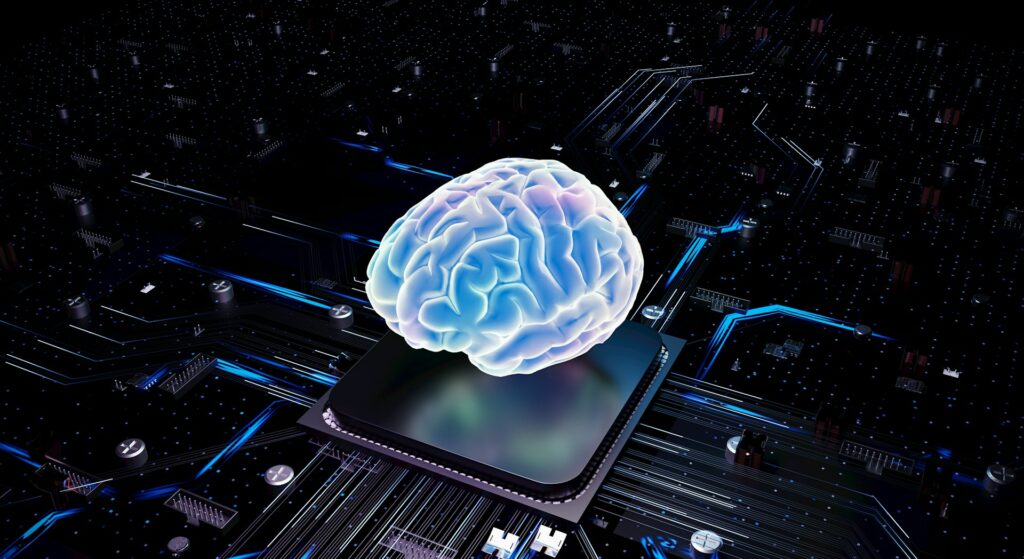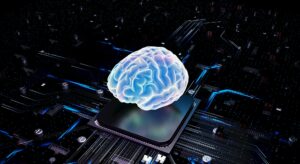In the future brain-computer interfaces will allow users to type with their thoughts.

In the future brain-computer interfaces will allow users to type with their thoughts.
Imagine you are sitting at your computer and writing an email, but instead of using your hands, you are actually using your mind. It seems as if your thoughts are being transmitted directly from your head to the screen as the pointer moves and the words emerge. This concept, which was formerly only found in science fiction, is now becoming a scientific reality as a result of the rapid growth of Brain-Computer Interfaces (BCIs). These systems, which convert brain activity into digital orders, are poised to transform the way in which humans interact with machines, thereby opening up new frontiers in the fields of communication, medicine, and human potential.
Acquiring Knowledge about Brain-Computer Device Interfaces
The term “Brain-Computer Interface” refers to a communication system that allows for direct connection between the brain and an external device. This interaction does not rely on the conventional motor pathways that are found in the body. In general, brain-computer interfaces (BCIs) are devices that decode the electrical impulses that are produced by the brain and then translate those signals into digital outputs. These digital outputs can include the movement of a cursor, the control of a robotic limb, or the typing of text on a screen.
That every thought, intention, or movement originates as a pattern of brain activity is the foundation around which this concept is built. This theory is both straightforward and profound. Through the process of recording and interpreting these signals, brain-computer interfaces (BCIs) bridge the gap between digital technology and biological cognition.
The Workings of Brain-Computer Interfaces: From Thought to Action
In order for a brain-computer interface to function properly, there are three primary processes that must be completed: signal acquisition, signal processing, and command execution.
In the first step of the process, neural activity is recorded by sensors that are either implanted directly into the brain (such as invasive BCIs) or put externally on the scalp (such as non-invasive BCIs). After that, these signals are processed by complex artificial intelligence algorithms that have the ability to recognize patterns that are connected with particular intentions, such as “move left” or “select letter.” At long last, the command that has been translated is transmitted to a connected device, therefore transforming mental activity into observable digital action.
This technique has seen a major improvement in its precision as a result of recent developments in machine learning software. Now that artificial intelligence systems are able to discern minor changes in brain activity, it is possible to translate thoughts into text or movement in a more timely and precise manner.
From a Necessity for Medical Treatment to Human Incorporation
Initially, the focus of BCI research was on recovering function that had been lost. BCIs provided a means of communication and interaction with the outside world for those who had previously been unable to do so due to conditions such as paralysis, stroke, or neurological disorders. The use of brain-computer interfaces (BCIs) has enabled patients to successfully operate robotic arms, control wheelchairs, and even communicate through synthesized voices, all of which are driven solely by their thoughts.
As a result of technological advancements, the applications are growing to include areas that go well beyond rehabilitation. The very same tools that were developed to restore communication for people with disabilities may eventually be used to improve talents for everyone. A natural extension of human cognition into the digital arena, typing with thoughts has the potential to become not just a medical marvel but also a convenience for the general public.
Using Artificial Intelligence to Decipher Thought
The development of thought-driven typing is largely dependent on the use of artificial intelligence. In a single second, the brain produces millions of electrical signals, which are equivalent to enormous amounts of data. For this chaotic activity to be decoded, artificial intelligence algorithms that are capable of pattern identification on an incredible scale are required. Deep learning systems are trained on the brainwave data of individual users in order to map particular patterns to language or motor goals.
It was proved by researchers in 2023 that artificial intelligence systems were capable of decoding full words directly from cerebral activity, and they did it with astonishing precision and speed. Reading words as they are produced in the mind, prior to their being uttered or written, is the goal of the next generation of models, which aspires to interpret silent inner speech.
Significant Advances in the Field of Thought-to-Text Technology
Thought-based communication has made significant strides forward in recent years thanks to recent developments. Neural recording devices with high resolution and the ability to wirelessly transmit data from the brain have been demonstrated by Neuralink, a firm that was created by Elon Musk and specializes in brain implants. In the meantime, academic projects at schools such as Stanford and UC San Francisco have achieved record-breaking typing rates using implanted electrodes. This has made it possible for individuals who are paralyzed to communicate at a rate that is nearly identical to that of regular speech.
These systems are dependent on artificial intelligence models that continuously learn from the brain activity of users, fine-tuning their accuracy through repeated use. The user interface will eventually evolve to the point that it will serve as an extension of the user’s own nervous system, becoming more intuitive with each session.
The Potential of Brain-Computer Interfaces That Are Not Invasive
BCIs that are implanted give the maximum level of precision; nevertheless, they also require surgery and are associated with certain medical hazards. Because of this, researchers are looking into non-invasive technologies such as electroencephalography (EEG) and functional near-infrared spectroscopy (fNIRS). Artificial intelligence-driven advancements in signal processing are helping to close the performance gap, despite the fact that these techniques are less precise.
The availability of thought-based typing could be made available to anyone in the future through consumer-grade devices such as headsets, glasses, or even earbuds. Just for a moment, try to picture yourself being able to compose messages, manage smart homes, or navigate virtual environments using only your thoughts.
Beyond the realm of communication, applications
The capabilities of brain-computer interfaces go far beyond typing. Retraining brain pathways could be accomplished through the use of thought-controlled gadgets in the medical field to assist stroke victims in regaining physical function. Through the use of neural input, students could have direct interactions with artificial intelligence instructors in the field of education. In the entertainment industry, brain-computer interfaces (BCIs) could provide players the ability to control characters or manipulate virtual worlds using just their imagination.
The possibility of cognitive improvement, which involves the use of brain-computer interfaces (BCIs) to improve memory, concentration, or creativity, is perhaps the most fascinating. It would be possible for humans to acquire information immediately if they were to link directly to digital knowledge bases. This would allow for the real-time integration of biological mind with artificial intelligence.
Concerns Regarding Ethical Imperatives
As BCIs continue to advance, ethical concerns become increasingly urgent. Who owns the information that could be recorded from the human brain? In what ways can we safeguard our thoughts, which are the most private type of information we possess, against being misused or monitored? Concerns regarding human rights and privacy are brought to the forefront by the possibility of “neurohacking,” also known as cognitive manipulation or the collecting of brain data without authorization.
In addition, the psychological effects of combining the human mind and the machine are yet unclear to a significant extent. If thoughts are able to be converted into digital form, is it possible that they may also be impacted in reciprocal fashion? As brain-computer interfaces (BCIs) advance from the laboratory to everyday life, it will be vital to ensure transparency, informed consent, and data security.
A Philosophical Approach to the Mind-Machine Union System
Beyond the realm of ethics lies a more profound philosophical inquiry: what occurs when our human thoughts expand into the realm of technology? From the wheel to the smartphone, the human brain has always made use of instruments to boost capabilities; nonetheless, brain-computer interfaces offer a significant jump in terms of quality. They incorporate technology into mind in such a way that the line between the self and the system becomes increasingly blurry.
The very concept of personality may undergo a transformation if thinking becomes entangled with digital networks. It is possible that future generations may not merely make use of computers; rather, they may fully integrate themselves into them, so combining human awareness with computational intelligence in ways that we are just beginning to conceive of.
Ways to Overcome Obstacles
Even while there has been amazing progress, there are still significant technological obstacles. Because of the inherent noise in brain signals and the fact that they differ from person to person, universal decoding models are challenging to implement. Another obstacle is the long-term stability of implanted electrodes; there is a possibility that the immunological response of the body would diminish the quality of the signal over time. When it comes to non-invasive systems, the primary focus continues to be on enhancing accuracy without the need of invasive equipment.
In addition, ethical governance is not keeping pace with the advancement of technology. It is imperative that global frameworks for safety, regulation, and privacy protection evolve concurrently with the race that private enterprises are participating in to commercialize brain interfaces.
The Way Forward: Typing at the Speed of Thought the Road Ahead
We may anticipate significant advancements in the performance of BCIs, as well as accessibility and affordability, during the course of the next ten years. Both machine learning and materials science will continue to increase implant biocompatibility, while machine learning will continue to optimize accuracy. As a result of their smooth integration with artificial intelligence assistants, augmented reality, and personal computing devices, non-invasive consumer brain-computer interfaces (BCIs) may become prevalent as headphones.
There is a possibility that traditional input methods will someday be surpassed entirely by typing with thoughts. We might be able to communicate directly from our brains to our devices, bypassing the physical boundaries that are present in interface design. This would be an alternative to using keyboards, touchscreens, or voice commands.
Towards a Mental and Mechanical Compatibility
More than just a step forward in technological development, the development of brain-computer interfaces marks the beginning of a new phase in the evolution of the human species. Through the integration of our mental processes with digital intelligence, we are expanding the scope of thought itself.
The idea of being able to type with our minds is no longer a far-off hypothesis; rather, it represents the next step toward the seamless integration of human consciousness and technology. Nevertheless, this power comes with a responsibility, which is to safeguard the privacy of one’s thoughts, maintain one’s autonomy, and make certain that innovation benefits mankind rather than the other way around.
In the future that is currently forming, cognition will not only serve to direct machines; rather, it will constitute the interface itself. The mind, which was long restricted to the skull, will eventually leave its confines and speak freely with the digital world. This dialog between the brain and the computer has the potential to reinvent what it is to think, create, and be human.




